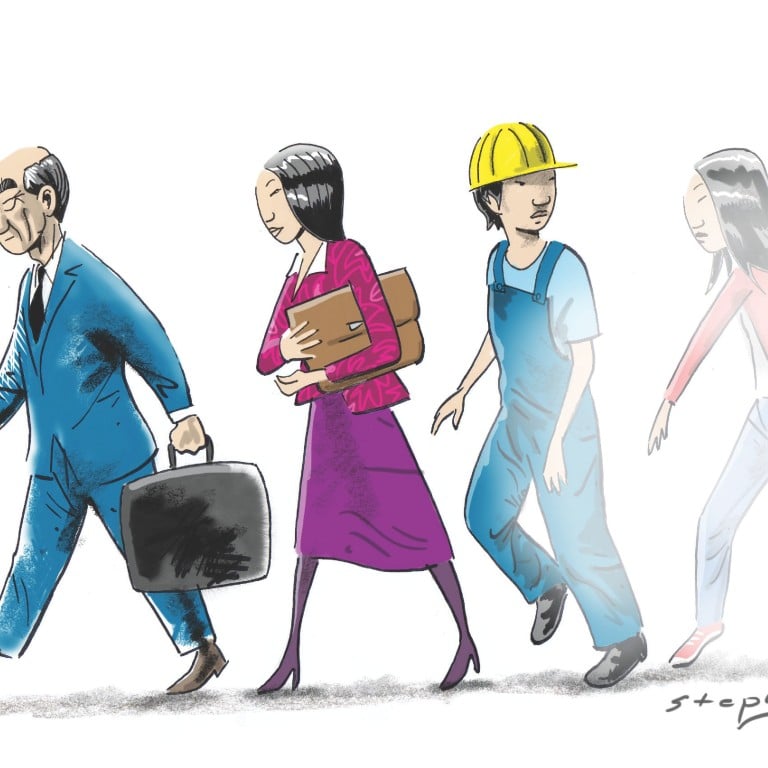
Hong Kong needs a flexible approach to work as the population ages
Timothy Peirson-Smith says Hong Kong must design and restructure jobs to appeal to people's changing needs in order to rejuvenate our dwindling workforce as the population ages
According to the government's consultation on population policy, Hong Kong's population is growing at just 0.6 per cent per annum, and worryingly by 2031, 28 per cent of the population will be aged 65 or above. With more people retiring than entering work, our labour force is estimated to peak in 2018 and decline by 6 per cent by 2031, risking harm to Hong Kong's future economic growth.
Thus, to ensure the city's continued development, all means must be considered to strengthen its dwindling workforce. This will necessitate not only plans to encourage and widen local participation in the workforce but also the agility to attract international talent and be more open to importing labour in the increasingly competitive and mobile market for the best and brightest.
Firstly, an ageing population brings into question the relevance of an absolute retirement age in the 21st century. By adopting a less rigid retirement policy, firms have the option of retaining effective and experienced workers. This, however, needs to be carefully balanced with protecting the career opportunities and progression of younger workers entering the job market and climbing the career ladder.
One issue faced by companies with employees close to retirement age is a lack of qualified individuals to fill vacancies in certain sectors. Construction and catering have seen a significant drop in the availability of suitable workers, for example.
One way to address this issue would be for the government to encourage local apprenticeships in the sectors in need.
Ethnic minorities also need to be supported and given assistance to join the workforce, which means considering and then addressing how the local education system is failing them.
The one-way permit system could also help alleviate some of the pressure, if control of accepted applicants was given to the Hong Kong government, allowing officials to recruit qualified individuals to fill gaps. Another measure would be to take steps to counter the prejudice against hiring workers with disabilities.
Hong Kong also needs to enhance its attraction to the best international talent. Issues mentioned most frequently in this regard include challenging air pollution, the struggle for school places and the lack of social support for families with two working parents. These are not just concerns for drawing international talent, but also for keeping local talent and, thus, urgently need to be addressed.
As outlined in the population policy consultation document, there has been a significant drop in the percentage of workers aged 30-39, directly linked to the fact that people marry and start families around these ages. To encourage more people in this age group to join the workforce, the lack of government-funded support for child care must be addressed.
Big companies have provided childcare facilities for Hong Kong employees since 1990, and while such companies are able to provide these services, some 80 to 90 per cent of businesses in Hong Kong are small or medium-sized enterprises. To them, the cost of providing childcare is an unacceptably large burden. Thus, it will fall to the government to take steps to provide subsidised childcare for working parents, to bring homemakers who want to work back into the labour force.
A more flexible attitude to working hours can also entice people back. There are several schemes to help people work while raising a family.
One option would be job sharing. This can benefit both employees and employers, as it provides the latter with a full-time service with double the creative energy and perspective, while part-time employment gives parents time to care for their children. Another scheme, being tried out in Europe by several major companies, is term-time contracts, where parents work during school terms but not during holidays, so they can be with their children.
For families where one parent works full-time and the other remains at home, schemes such as these could potentially increase household income and draw homemakers back into the workforce.
In sum, Hong Kong could adopt greater flexibility in working hours, retirement age and immigration. The government needs to do more to integrate immigrants into local society, attract international talent and support parents by enabling them to care for their children and maintain a job.
The prejudice against hiring workers with disabilities is hindering Hong Kong's development. Companies and the government need to provide certain jobs in their organisations to this demographic.
While Hong Kong faces a significant drop in its workforce in less than five years, these ideas illustrate the potential action that the government and businesses, both local and international, can take in the short to medium term to boost the dwindling workforce. All have key roles to play and a more flexible approach to supplementing labour supply will be essential if Hong Kong is to sustain and develop its pre-eminent position as a global business centre.
